|

Spring 2006 (14.1)
Pages
72-79
Stalin's Death
His Legacy Still Haunts Us: Reflections Upon Stalin's Death
by Murtuz Sadikhli
  When
Murtuz Sadikhli (1929-1997) was eight years old, his family was
rounded up from their village of Nakhchivan and shipped out in
cattle cars to Kazakhstan. It was a tortuous journey that took
39 days. That was the dreadful year of 1937. When
Murtuz Sadikhli (1929-1997) was eight years old, his family was
rounded up from their village of Nakhchivan and shipped out in
cattle cars to Kazakhstan. It was a tortuous journey that took
39 days. That was the dreadful year of 1937.
During Stalin's rule (mid-1920s to 1953), millions of people
living in Soviet territory were exiled to hard labor or political
prison camps, thus providing a huge pool of cheap labor for building
major projects throughout the vast Soviet territory, especially
in sparsely populated regions such as Kazakhstan, Tajikistan
and Turkmenistan.
An estimated 300,000 Azerbaijanis were among these deportees;
100,000 of them were sent to Kazakhstan. Of these, approximately
30,000 exiles came from the Nakhchivan region [pronounced NAHKH-chi-vahn]-that
non-contiguous region, separated from western Azerbaijan by a
narrow strip of Armenian territory.
  Documents
indicate that during the 10-day period between August 5-15, 1937,
there were 1,957 people in Nakhchivan arrested and exiled. Murtuz
and his family, who lived in the village of Nus-Nus in the Ordubad
region, were among those unfortunate victims. Documents
indicate that during the 10-day period between August 5-15, 1937,
there were 1,957 people in Nakhchivan arrested and exiled. Murtuz
and his family, who lived in the village of Nus-Nus in the Ordubad
region, were among those unfortunate victims.
It was 10 years later (1947) before Murtuz succeeded in finding
a way to leave the camp and return to his native Nakhchivan.
He survived, his grandfather and many others didn't.
Over the years that passed, he felt compelled to tell his story
and wrote his memoirs in a book entitled, "Memory of Blood"
[Qan Yaddashi. Baku: Yazichi Press, 1991, 208 pages. ISBN: 5-560-00693-9].
The following excerpt reflects his thoughts in 1988 as he looked
back upon the significance of Stalin's death in 1953 (pages 197-200).
Memories of 1953
In March 1953, many rumors were circulating about Stalin not
being well. The newspaper Pravda wrote something about it, and
then a day or two later, the radio and newspapers announced that
Stalin had died (On March 1, 1953, after an all-night dinner
with interior minister Lavrenty Beria and future premiers Georgi
Malenkov, Nikolai Bulganin and Nikita Khrushchev, Stalin collapsed
in his room, having probably suffered a stroke that paralyzed
the right side of his body. Although his guards thought it odd
that he did not rise at his usual time the next day, they were
under orders not to disturb him so his body was not discovered
until that evening. Four days later, on March 5, 1953, he died.
He was 74. An enormous state funeral was held in Moscow on March
9. Officially, the cause of death was listed as a cerebral hemorrhage
though it is said that Beria claimed to have poisoned him.
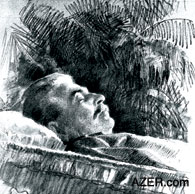  Stalin's
body was preserved in Lenin's Mausoleum until October 31, 1961
when he was removed to the row of graves behind the mausoleum
- Wikipedia, April 20, 2006). Stalin's
body was preserved in Lenin's Mausoleum until October 31, 1961
when he was removed to the row of graves behind the mausoleum
- Wikipedia, April 20, 2006).
Left:
"Joseph Stalin in Coffin"
by A. N. Yar-Kravchenko.
A Day of Mourning was declared throughout the Soviet Union. Flags
were lowered. At every institution, there were honorary guards
assigned to stand beside the portraits of Stalin. In our office,
I was among those given this "honorary duty" - my colleague
Gasim and I.
Many people were genuinely weeping, while others only pretended
to be. Some were sure that the world would come to an end. Everybody
was wondering what would happen to us without Stalin. I can't
remember what my particular feelings were that day, but after
the funeral ceremony, Gasim and I took a walk in the city park
next to our institute.
"Stalin's death will bring many changes in the country,"
he told me. We were sure that this day would leave its mark on
our destiny.
The tyrant was gone. Nature itself had brought an end to his
existence. Nature had lost its patience and snuffed out the life
of this individual whom the people, themselves, were not able
to get rid of. Nature is the Earth, which just happens to be
one-third water. And water doesn't tolerate filth. Nature had
lost its patience and made its demands at the precise moment
when people were so helpless.
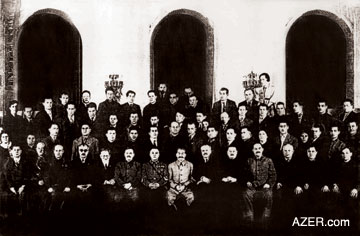  Left: Delegation of the 18th Congress of Supreme Communist
Party, the Kremlin, Moscow, 1937. Stalin is seated in the center
on the first row in the light-colored suit. Mir Jafar Baghirov,
First Secretary of the Communist Party in Azerbaijan and "Stalin's
right hand man" in Azerbaijan is seated on first row, fourth
from the left (glasses). Mikhail Ivanovich Kalinin (1875-1946)
is seated next to him (with beard). Kalinin became the President
of the Presidium of the Supreme Soviet, a position he held until
1946. Left: Delegation of the 18th Congress of Supreme Communist
Party, the Kremlin, Moscow, 1937. Stalin is seated in the center
on the first row in the light-colored suit. Mir Jafar Baghirov,
First Secretary of the Communist Party in Azerbaijan and "Stalin's
right hand man" in Azerbaijan is seated on first row, fourth
from the left (glasses). Mikhail Ivanovich Kalinin (1875-1946)
is seated next to him (with beard). Kalinin became the President
of the Presidium of the Supreme Soviet, a position he held until
1946.
Years have passed. History
is the judge of everything. People have since discovered what
a tyrant Stalin was. They have begun to understand the extent
of the crimes that he committed. In an article published in Pravda
on March 30, 1989, he was described as having been a secret agent
of the Czar's government.
And now these days [1991], they are writing that Stalin was a
schizophrenic. They sometimes even compare him with Herod (King
of the Jews), Caligula and Nero (Roman emperors), Ivan the Terrible
(Russia), or Hitler (Germany). How could such a sick person be
in charge of such a huge country?
The Soviet people have finally become conscious of the real nature
and character of their forefathers. They have come to understand
what trouble this tyrant had done to them-this forefather whom
they used to believe in. So many innocent people of the Motherland
were victimized by his policy.
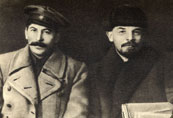  Rumors Rumors
Will history ever forget the wounds inflicted by his axe that
were carried out against Azerbaijan's culture in the 1930s? It
was so violent. So many intellectuals were killed. So many valuable
manuscripts, so many cultural archives were destroyed.
Left: Joseph Stalin and Vladimir Lenin in
March 1919.
Rumors have it that even one of the women who worked in the NKVD
(via Russian, Narodniy Komissariat Vnutrennikh Del: People's
Commissariat for Internal Affairs - This was a government department,
which handled a number of the Soviet Union's affairs of state
but was notorious for their arrests, imprisonments, exiles and
executions.
It was the forerunner of the KGB, the secret police agency of
the Soviet Union) canteen used to sell gutab (Azerbaijani traditional
cuisine consisting of a crepe thinly layered with either minced
meat, white cheese, spinach or pumpkin) that she had wrapped
up in some of the original papers on which folklorist Salman
Mumtaz (Azerbaijani folklorist [1884 and died either in 1941
(Azerbaijan Encyclopedia), 1937 (Writers' Encyclopedia) or 1938
(Writer's Union). He was arrested during Stalin's purges and
died in exile. Unfortunately, the reference books do not even
know the exact date of his death) had painstakingly collected
and documented ethnographic material.
Even today it's difficult to think back on those bloody pages
of history. In 1937-38 they were executing people in a forest
outside of Minsk (the capital city of Belarus) Later when mushrooms
began to sprout there, rumors spread that the mushrooms were
reddish in color and people refused to pick them. They would
question what the origin of those mushrooms was and pass on by.
So much blood was shed during those years in Azerbaijan, too-perhaps,
more blood than rain. Who knows? Maybe even such mushrooms started
to grow here as well.
It wasn't long after Stalin's death that they started to reveal
some of his criminal activities (Khruschev's "Secret
Speech". One of the most devastating blows to Stalin's
reputation was the "Secret Speech" that Nikita Khrushchev
(1894-1971) as Party Secretary made at the 20th Congress of the
Communist Part of the Soviet Union in February 1956.
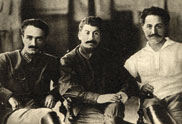  Left: Active partners in the Caucasus: Anastas Mikoyan,
Joseph Stalin and Grogoriy Ordzhnokidze, Tiflis (now Tbilisi),
1925. Left: Active partners in the Caucasus: Anastas Mikoyan,
Joseph Stalin and Grogoriy Ordzhnokidze, Tiflis (now Tbilisi),
1925.
During the morning's
closed session of the last day (February 26), Khrushchev took
the opportunity to give a stinging rebuke of the policies of
Stalin, his late predecessor. Khrushchev denounced Stalin's cult
of personality, and Stalin's apparent support of the concept
of individuality. He went on to denounce a list of crimes committed
by Stalin's supporters, many of which had previously been denied
by the Soviet Union.
The speech shocked the delegates to the Congress, as it flew
in the face of years of Soviet propaganda, which had claimed
that Stalin was a wise, peaceful, and fair leader.
After long deliberations, in a month the speech was reported
to the general public, but the full text was published only in
1989 - Wikipedia, April 13, 2006). But still, it was a long time
before anyone ever mentioned the names of his closest associates.
His colleagues such as Molotov (Vyacheslav Mikhailovich Molotov
(1890-1986) was a Soviet politician and diplomat and a leading
figure in the Soviet government from the 1920s, when he rose
to power as a protégé of Joseph Stalin. He became
Chairman of the Council of People's Commissars, the equivalent
of a prime minister, in December 1930.
Molotov carried out Stalin's line of using maximum force to crush
the peasant resistance to collectivization, including the deportation
of millions of kulaks, who were peasants with property, to labor
camps, where most of them died. In 1939 he became the Foreign
Minister. He was dismissed from the office by Nikita Khrushchev
in 1956 [Wikipedia: April 16, 2006]), Malenkov (Georgy Maximilianovich
Malenkov (1902-1988) was a Soviet politician and Communist Party
leader, and a close collaborator of Joseph Stalin. He briefly
became leader of the Soviet Union (March September 1953)
after Stalin's death and was Premier of the Soviet Union from
1953 to 1955.
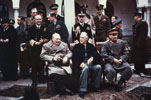  Left: Yalta Conference, February 1945. Allied leaders
pose in the courtyard of Livadia Palace, Yalta, during the conference.
Those seated are (left to right): Prime Minister Winston Churchil
(UK), President Franklin D. Roosevelt (USA), and Premier Joseph
Stalin (USSR). From Army Signal Corps Collection in the U.S.
National Archives. Left: Yalta Conference, February 1945. Allied leaders
pose in the courtyard of Livadia Palace, Yalta, during the conference.
Those seated are (left to right): Prime Minister Winston Churchil
(UK), President Franklin D. Roosevelt (USA), and Premier Joseph
Stalin (USSR). From Army Signal Corps Collection in the U.S.
National Archives.
Together with Lavrenty
Beria, Malenkov aided Stalin during the purges of the late 1930s
[Wikipedia: April 6, 2006]), Kaganovich (Kaganovich (1893-1991),
a close associate of Joseph Stalin was considered by some scholars
to be one of the worst mass murderers in history because he helped
to engineer the 1932-33 famine in Ukraine, in which 7 to 10 million
people died. He died at age 97, a few months before the final
unraveling of the Soviet Union [Wikipedia: April 13, 2006]) and
dozens of others continued their life in peace.
In fact, Kaganovich is still alive (Murtuz Sadikhli wrote this
article for Kommunist newspaper on January 27, 1989, at which
time Kaganovich was still alive. Kaganovich died in 1991, the
year that the Soviet Union officially collapsed) (as of January
27, 1989, when I was writing editing this article).
The trial of Lavrenty Beria (Lavrenty Pavlovich Beria, Soviet
politician and chief of the Soviet security and police apparatus.
He was the executor of Joseph Stalin's Great Purge of the 1930s,
even though he actually presided only over the closing stages
of the purge. After Stalin's death he was removed from office
and executed by Stalin's successors) began on December 18, 1953,
and continued for five days before the verdict was announced.
So many crimes were revealed during the investigation.
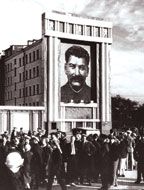  Left: Example of the "Personality Cult" that
was fastered by Stalin. Left: Example of the "Personality Cult" that
was fastered by Stalin.
It was also exposed
that Beria had contracted syphilis in 1943. His assistants had
instructions to kidnap pretty women that they saw on the streets
of Moscow and take them to Beria. During the trial, they started
to list the names of the women whom Beria had raped, and a representative
from Georgia stood up and asked that the list not be read further.
He was afraid it might include the names of wives of all the
men that held leading positions.
The trial of Mir Jafar Baghirov (Mir Jafar Baghirov was Stalin's
right hand man in Azerbaijan as Secretary of the Central Committee
of Azerbaijan Communist Party. He was dismissed from the office
and put on trial after Stalin's death in 1953 and executed) -
Beria's assistant in Azerbaijan-followed. If I'm not mistaken,
it was in April 12, 1954. The whole nation was anxiously following
this trial, waiting for the verdict.
Even though Stalin had already died, Stalinism was quite well
and alive. We carried those years on our shoulders like a heavy
load. The truth is: we are still being crushed under that enormous
burden today.
When I was studying in my second year at the Institute, I had
a course about ancient Slavic language. Our textbooks were old.
Strangely, these outdated books aroused a deep interest in religious
literature. I used to write down expressions that I liked in
my diary. One of those aphorisms was: "Damned when you enter:
damned when you leave". Even today these words seem to describe
me and others like me. I have never felt independent. I have
always felt under pressure. Always. And I have also always felt
this pressure weighing upon my nation.
|
"Even though Stalin had
already died, Stalinism was quite well and alive. We carried
those years on our shoulders like a heavy load. The truth is:
we are still being crushed under that enormous burden today."
--Murtuz Sadikhli
Exiled with his family in 1937 to Kazakhstan
|
Karl Marx writes that a mistake made by a nation is as unforgivable
as one made by a virgin who yields to the first incidental swindler;
a nation should never make such a mistake! Years pass, many things
are wiped from our memories, but the experiences that happened
during those years still make people pause. People write: but
you sense that they are still afraid to write the truth. And
we need the truth. We desperately need to know the truth about
our past. Sadly, the number of those who witnessed those years
is diminishing by the day.
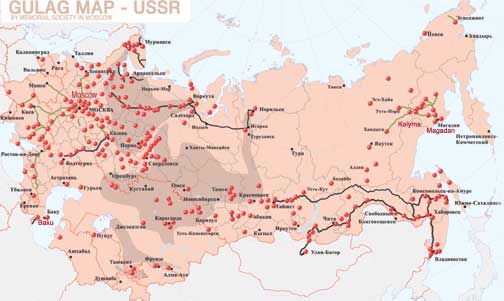
Above: Gulag Map showing where all the prison
camps were located during Stalin's era. This map was prepared
based on the directory of "System of Corective Labor Camps
in the USSR" published by Memorial Association in 1998.
All the main camps in the USSR between 1923-1961 are designated.
Of course, at certain times, there were fewer camps, but this
map reflects a composite of all of the camps. Symbols: (1) Circles:
Regional administration (departments) of maps and colonies. (2)
Green lines: Roads built by prisoners. (3) Black lines: Railway
roads built by prisoners. (4) Gray areas: Territories where exiles
were sent in mass. Courtesy: International Memorial Society,
Moscow, per Jan Raczynski. For more information about the Gulag
and memoirs of prisoners who were repressed, visit: www.memo.ru
(Web site in Russian, English and German).
Many years ago, I wrote down everything (Elsewhere in his book
"Memories of Blood", the author Sadikhli mentions that
he started writing his memoirs in the 1950s when he returned
from exile to Azerbaijan. It wasn't until 1991-nearly 40 years
later - that he was able to publish them) that had happened to
me when our family was sent into exile into Kazakhstan in 1937.
At that time I would never have imagined that the day would come
when my memoirs would be published. But in September 1988, Kommunist
newspaper published a selection of my memoirs.
Editor's note: Murtuz Sadikhli's book was published in 1991.
The first chapter of his book appeared in English in our magazine
in 1999. To read about the traumatic journey that the Sadikhli
family made from Nakhchivan to Kazakhstan, see Azerbaijan International:
"Exile to Kazakhstan: Stalin's Repression of 1937,"
by Murtuz Sadikhli. AI 7.3 (Autumn 1999). Search at AZER.com.
Read other excerpts from "Memory of Blood" in this
issue [Qan Yaddashi. Baku: Yazichi Press, 1991, 208 pages. ISBN:
5-560-00693-9].
Back to Index AI 14.1 (Spring
2006)
AI Home
| Search | Magazine
Choice
| Topics
| AI Store | Contact us
Other Web sites
created by Azerbaijan International
AZgallery.org | AZERI.org | HAJIBEYOV.com
|









